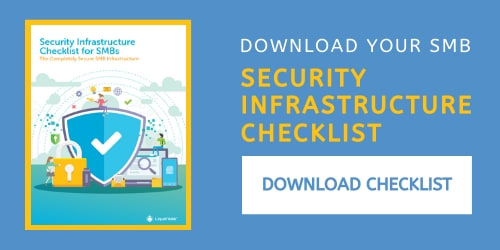
In 2013, Yahoo had an internal data breach that encompassed 3 billion accounts. The company publicly announced that the incident had occurred during the process of being acquired by Verizon. It was later revealed that while accounts and security questions were stolen, no payment information was accessed. To date, it is still one of the largest enterprise cybersecurity breaches on record.
Yahoo is not alone. Big names such as LinkedIn, Facebook, Marriott, and Sina Weibo have all had data breaches of their own. Had Yahoo thoroughly investigated probable security risks, they may have been better prepared to handle those changes to a new system more effectively.
If large companies with huge amounts of resources at their disposal have cybersecurity issues, then the small business is even more at risk. Your business can be seen as an easy target for hackers and malware if your systems are not kept up to date.
By following the steps in this article, you can protect yourself and your small business from the most common cyber attacks.
What is Enterprise Cybersecurity?
Enterprise cybersecurity is the practice of protecting company data and resources from cyber threats. It uses traditional cybersecurity methods of protecting data locally and extends that idea to the transfer of data across networks, devices, and end users. Enterprise cybersecurity not only deals with common security issues such as Denial-of-Service (DoS) attacks, social engineering, and software vulnerabilities, but it also takes into account how data is transferred between devices and networks within the organization as a whole.
Why is Enterprise Cybersecurity Important?
Cyber threats and data leaks can be prevented and mitigated using good enterprise cybersecurity practices, such as developing and defining your scope of security, studying enterprise architecture, and utilizing traditional cybersecurity methods. These practices can help protect your organization from cybersecurity breaches.
Cyber Threats
Here are two major cyber threats you need to be aware of:
- SQL Injection: This injection technique targets the site and database directly. When successful, the assailant can enter a piece of SQL code that, when executed, allows access to sensitive information or even gives database editing privileges to the cyber criminal.
- DDoS (Distributed-Denial-of-Service) Attack: This is a direct attack on your network. It targets a server with an intent to bring it offline for various purposes. Cyber attackers can also use this attack type to hide other attack vectors, which are more difficult to identify since everyone is focused on the DDoS attack and fixing the offline server.
Data Leaks
A data leak is a breach of security. Confidential or sensitive data is stolen or copied by individuals that are not authorized to do so. Weak passwords can often be the root cause of this, but it can also be caused by:
- Phishing: Phishing is one of the most popular types of scams on the web. Emails are sent under the guise of a fellow employee asking you to immediately act to prevent some unwanted event. An example would be an email telling you that you will lose access to your computer if you do not provide your password. With this information, they can use the data to create more havoc and steal even more sensitive data.
- Baiting: Baiting uses your curiosity against you. Hackers leave malware or virus on a USB or similar device in a well traveled area or break room. This is in the hope a curious passerby will pick it up and try to use it. Once used, it activates and installs malware to company systems and computers.
- Scareware: Scareware involves spamming the victim with threats, trying to trick them into clicking a link. A pop up stating “Your pc is infected with malware, click here to resolve!” is an example of scareware. Once the user clicks the erroneous link, their company or server is injected with malware, giving the attacker access to their system.
- Pretexting: Pretexting is done by gaining someone’s trust that has access to sensitive information. Malicious actors using pretexting will pose as someone of authority such as a tax official, police officer, or a fellow employee. Once trust is established, they will ask a series of questions in an effort to gain sensitive data such as credit card numbers, accounts, and passwords.
Consequences of a Successful Cyber Attack
Both customer data and private company data are at risk during a cyber attack. But when a cyber attack is successful, companies lose more than just data; they lose integrity with customers and potential business partners.
- Financial Loss: Companies will lose potential sales as systems go down due to a cyber attack or are forced to shut down to contain it.
- Reputation Loss: If your customers and partners are unable to access their data or your systems, your reputation will suffer.
- Data Loss: Depending on the type of attack, your data could be compromised, stolen, or lose integrity.
These issues are not limited to large businesses either. They affect companies of all sizes that have data stored using technology.
It’s imperative that businesses make an effort to practice proper enterprise cybersecurity and prevent possible data leaks before they happen.

Enterprise Cybersecurity Best Practices
Here are five crucial enterprise cybersecurity best practices you need to employ today:
1. Define Your Scope of Security
Answer these questions to understand your scope of security better:
What Devices Do You Use to Connect to Data?
Any software, hardware, or third-party apps should be secure and up to date. Passwords should never be shared with anyone. Be sure to use strong passwords, including numbers and letters that are not easily guessable. A strong password policy should be enforced throughout your company.
What Software and Hardware Do You Use Daily?
Delete or uninstall any software that is no longer used, and remove any unused hardware. If you’re not using an app because the company decided to upgrade to a more streamlined version, delete the old ones off your systems.
Where is Your Data Stored?
You should only allow access to your data via secure methods and with up-to-date programs and devices. Knowing where your data is stored (on-premise, in the cloud, or a mix of both) will be extremely important.
Having fewer ways to access your data leaves fewer ways for cyber threats to access it as well.
How Do You Connect to Your Data?
Networks should be secured and necessary ports blocked to prevent access. Also, think about adding a VPN to your internal network for added security. Have your network team monitor your connections and ports to ensure traffic to your network is valid.
2. Take Advantage of Enterprise Architecture
Enterprise architecture (EA) creates a blueprint for how and when you want to grow your business. It analyzes the fastest way to get to your business goals by planning and analyzing trends in existing data. This architecture type is used to improve profitability, move a business online, or open new branches of product development.
Enterprise architecture can be used to help newly launched security departments tackle cyber security issues. It will help you set forth a plan from conception to implementation based on corporate data trends.
Also, EA can be used for the implementation of new company software or devices. For example, your team may want to change the main software that runs your ticketing system. Having an enterprise architecture team will allow you to plan for what the new software will need.
By using EA, you can find the best way to proceed and establish a timeline for your company’s goals and business operations.
The key to enterprise architecture is to see where your business is headed, so you can plan for the future and stay in front of any trends. Planning ahead allows you to implement security for new features before they happen and be a leader for emerging cyber threats.
3. Secure Your Data
Make sure that employees have proper training across your company to handle sensitive information. For example, give them security training on the common causes of a data breach, phishing, social engineering, bating, scamware, and pretexting.
Use secure passwords and two-factor authentication to access sensitive data. Larger companies can implement a key card system to access company grounds and establish a VPN or internal network that is not accessible directly from the Internet. Secure internal email gateways to prevent fraudulent and phishing emails to unsuspecting employees. Be sure to monitor your network for threats or suspicious activity.
Once these steps are in place, perform routine access audits to ensure those security measures are working.
Each part of your scope of security and access points should be tested for vulnerabilities. If a compromise is found, it needs to be rectified. These tests should encompass all hardware and software elements of your data and data transfers.
Granted, data transfer will occur as you run your business. The key is to make sure you limit how data is transferred and make sure when you do move data, it is as securely as possible.
4. Limit Access Privileges
Run audits on your access to make sure only those qualified to make changes to programs or devices are allowed access to sensitive data. If it is not necessary for them to have administrative access, limit their use.
You want to only have a handful of people with full administrative access across your entire enterprise. Any employees that have left the company should have their access and profiles removed from the system as soon as possible. Passwords to admin access should not be saved or stored.
5. Have a Backup Plan
No matter what you do, technology is always changing and improving. Even the most up-to-date networks can suffer a data leak. A remediation plan for data backup and disaster recovery will help any enterprise-level business to consolidate and mitigate losses in the event of a data leak.
When you have a plan and a protocol in place before a breach in data, it will allow you and your team the ability to deal with it as quickly as possible. Once the cause is found, you and your team can be ready to patch and rectify the issue.
Liquid Web Knows Cybersecurity
As technology improves, the need for enterprise cybersecurity to protect your digital assets from cyber threats becomes an even more imperative part of your business. Liquid Web takes security very seriously and is dedicated to helping customers achieve their enterprise cybersecurity goals.
[ad_2]
Source link


![Enterprise Cybersecurity [Definition & Best Practices]](https://dealzclick.com/wp-content/uploads/2022/01/CES-2022-MSI-Unveils-Series-of-Laptops-With-Up-to.jpg)
![Enterprise Cybersecurity [Definition & Best Practices]](https://dealzclick.com/wp-content/uploads/2022/01/Abundant-Mind-Visualization-Videos-For-The-Law-Of-Attraction.jpg)



